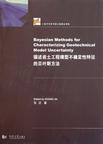描述岩土工程模型不确定性特征的贝叶斯方法
2011-11
同济大学出版社
张洁
161
无
As any model is only an abstraction of
the real world, model uncertainty always exists. Ingeotechnical
engineering, the model uncertainty could be large. Lack of
knowledge about modeluncertainty may lead to unrealistic
predictions. When back analysis from observed performances,model
uncertainty is often mixed with parameter uncertainty and
observational uncertainty. Hence itis generally difficult to
isolate and characterize model uncertainty. This book introduces
the state-of-the-art theories and methodologies for geotechnical
model uncertainty characterization based on theBayesian theory,
including both rigorous solution and approximate but practical
solutions, where theeffects of parameter uncertainty and
observational uncertainty on model uncertainty characterizationare
appropriately addressed. The theories and methodologies are
illustrated in detail with variousgeotechnical problems. The book
will be of general interest to readers in the profession
andparticularly useful for those specializing in geotechnical
inverse analysis and geotechnical reliability.
Preface
Chapter 1 Introduction
1.1 Background
1.2 Objective and Scope
1.3 Organization of the Book
Chapter 2 Literature Review
2.1 Within-System Characterization
2.1.1 Least Square Method
2.1.2 Maximum Likelihood Method
2.1.3 Bayesian Method
2.1.4 Extended Bayesian Method
2.1.5 Model Comparison and Multi-model Inference
2.2 Cross System Characterization
2.3 Bayesian Method and Computational Techniques
2.3.1 Maximum Posterior Density Method
2.3.2 First order Second moment Bayesian Method (FSBM)
2.3.3 Laplace Method
2.3.4 System Identification Method
2.3.5 Sampling Based Methods
2.4 Summary
Chapter 3 Bayesian Framework for Characterizing Model Uncertainty
3.1 Parameter, Model, and Observation Uncertainties
3.2 Bayesian Estimation of Model Uncertainty
3.2.1 Extension to Multiplicative Model Correction Factor
3.2.2 Extension to Censored Observed Data
3.2.3 Extension to Model Correction Functions
3.3 Characteristics of Cross System Model Uncertainty
Characterization
3.3.1 Role of Prior Information
3.3.2 Interpretation of Determined Model Uncertainty
3.4 Assignment of Prior Uncertainties
3.4.1 General Guidelines for Determining f(xi)
3.4.2 Prior Distribution for Model Uncertainty Parameters
3.5 Decision Involved in Model Uncertainty Characterization
3.5.1 Selection of Model Correction Factors
3.5.2 Use of Model Correction Function
3.6 Prediction of System Responses
3.7 Possible Solutions to the Bayesian Framework
3.8 Summary
Chapter 4 Simplified Bayesian Framework for Characterizing Model
Uncertainty
4.1 Introduction
4.2 Approximate Formulation for Characterizing Model Uncertainty
4.3 Discussion of Prior Distributions on Model Uncertainty
Parameters
4.4 Characterizing Model Uncertainty based on the Approximate
Formulation
4.4.1 Maximum Posterior Density Method
4.4.2 Grid Calculation Method
4.4.3 MCMC Simulation
4.5 Comparison of Model Uncertainty Factors
4.5.1 Spreadsheet Method
4.5.2 Grid Calculation Method
4.6 Approximate Prediction of System Response
4.7 Extension to Model Correction Functions
4.8 An Illustration Example
4.8.1 Background
4.8.2 Prior Knowledge in Model Uncertainty Parameters
4.8.3 Test Uncertainty
4.8.4 Calculation of μG(x) and σG(x)
4.8.5 Spreadsheet Implementation of the Maximum Posterior
Method
4.8.6 Comparison of Methods for Model Uncertainty
Characterization
4.9 Summary
Chapter 5 Efficient Markov Chain for Identifying Geoteehnieal
Model Uncertainty
5.1 Introduction
5.2 Study of Efficient Markov Chain for Characterizing Model
Uncertainty
5.2.1 Markov Chains under Investigation
5.2.2 Comparison of Markov Chains
5.3 Hybrid Markov Chain for Model Uncertainty Characterization
in the Original Bayesian Framework
5.3.1 Structure of the Hybrid Markov Chain
5.3.2 Determination of the Jumping Functions
5.3.3 Check of Convergence
5.4 Application to the Slope Stability Model Example
5.4.1 Performance of the Markov Chain
5.4.2 Check of Convergence
5.4.3 Posterior Distributions
5.4.4 Accuracy of Approximate Methods
5.5 Extension to Model Correction Function Calibration
5.6 Summary
Chapter 6 Probabilistic Back-Analysis of Slope Failure
6.1 Introduction
6.2 Further Study on Model Uncertainty of Limit Equilibrium
Methods
6.2.1 Effect of Test Uncertainty
6.2.2 Effect of Quality of Test Data
6.2.3 Effect of Amount of Test Data
6.3 Back Analysis of Slope Failure with Unknown Model
Uncertainty
6.3.1 Bayesian Formulation
6.3.2 MCMC Simulation
6.3.3 Response Surface Approximation
6.3.4 Illustrative Example
6.4 Back Analysis of Slope Failure with Known Model Uncertainty
6.4.1 Theory of Back Analysis with Known Model Uncertainty
6.4.2 Step-by-step Implementation
6.4.3 Reanalysis of Shek Kip Mei Landslide
6.5 Summary
Chapter 7 Reliability Based Design of Pile Foundation
7.1 Introduction
7.2 Problem Description
7.3 Model Uncertainty Characterization
7.3.1 Model Uncertainty Characterization Using Approximate
Methods
7.3.2 Model Uncertainty Characterization in the Original
Bayesian Framework
7.3.3 Comparison of Results
7.3.4 Effect of Data Censoring on Model Uncertainty
Characterization
7.3.5 Role of Model Uncertainty in Pile Capacity Prediction
7.4 Comparison of Probabilistic Models for Model Uncertainty
Characterization
7.4.1 Use of Additive Model Correction Factor
7.4.2 Use of Model Correction Functions
7.5 Reliability Based Design of Pile Foundations
7.5.1 Design Point Method
7.5.2 Application to Pile Capacity Model
7.5.3 Adjustment in Consideration of Structural Codes
7.5.4 Regression Analyses of Partial Factors
7.6 Reliability Based Design with Effective Stress Approach
7.7 Comparison of the SPT Method and Effective Stress Method
7.8 Summary
Chapter 8 Characterizing the Model Uncertainty of a Liquefaction
Model
8.1 Introduction
8.2 Problem Description
8.2.1 Liquefaction Model under Investigation
8.2.2 Calibration Database
8.2.3 Parameter Uncertainty
8.3 Determination of Model Uncertainty
8.3.1 Bayesian Formulation
8.3.2 Choice-based Sampling Bias
8.3.3 Prior Probabilistic Analysis of Liquefaction Data
8.3.4 Calibration Results
8.3.5 Role of Model Uncertainty in Liquefaction Potential
Evaluation
8.3.6 Determination of Target Factor of Safety
8.4 Summary
Appendix A
Appendix B
References

无
翻了一遍,没什么新的东西